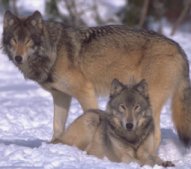|
Wolves are very social animals, and live in a family type unit called a pack. Packs can range anywhere from two wolves to over twenty wolves. Most packs in the continental United States have six to eight wolves, while packs in Alaska and Canada have between ten and twenty wolves. The pack is generally made up of an adult male and female that have mated and produced offspring. Generally, the pack is made up entirely from wolves that are related to each other, although a non-related wolf may become a member of a pack.
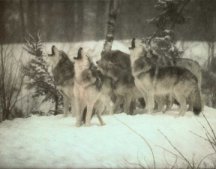
|
The pack follows a strict hierarchy to help maintain order within the pack. The main rankings in the hierarchy are alpha wolf, beta wolf, and omega wolf. The alpha wolf is the lead wolf and is the dominant wolf of the pack. The next in line is the beta wolf. The beta wolf often acts the caretaker of the pups, as well as the disciplinarian to reinforce the alpha's decisions. The omega wolf is the lowest ranking member of the pack. The omega wolf is subordinate to all other wolves in the pack and must often feed on prey when the rest of the pack is done. The rankings often go in pairs, so that there is a male and female of each rank, but this not always the case. Most often, there is an alpha male and alpha female, but there may not be pairings for the rest of the rankings. The other wolves fall between the beta wolf and the omega wolf.
|
The alpha wolf often displays very confident characteristics. The alpha wolf has a very confident stride, generally has the tail raised, and ears forward. Often even a look or glare from the alpha wolf is enough to cause another wolf in the pack to display subordinate behavior, such as tucking the tail or lower the body and crawl to the alpha wolf.
The pack is a very tightly knit, highly organized group. For survival a pack will travel, hunt, protect territory and raise pups together. Many experts believe that the pack is one of the tightest social organizations known to man.
|
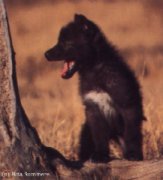
|
Wolf pups are born after a gestation period of 9 weeks. They are born in litters of between 2 and 10 pups. When first born, wolf pups cannot see or hear, and they need to stay close to their mother for warmth. They only weigh about one pound. They stay in the den for the first few weeks of their lives, spending most of their time eating and sleeping. After the first two weeks, their eyes open. After three weeks, they can hear and walk, and they start eating solid food, this is usually regurgitated, partially digested food supplied by one or both the parents. When the wolf pups are about a month old, they finally get to meet the rest of the pack.
|
|
Once the pups leave the den, they are looked after by the entire pack. The pups bond with the other wolves in the pack. The older pack members help by bringing food back for the young pups and watching for predators like eagles and hawks who might try to take the pups. After the wolf pups are nine weeks old, the pack moves from the den area to a site where the pups can safely play while the rest of the pack hunts.
|
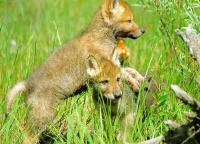
|
Through playing, the pups practice skills that will be important later in their lives, like pouncing, fighting and chasing. They even attack the older wolves, which put up with all their energy pretty well. Playing helps the pups establish a social order among themselves.
Wolf pups do not begin to hunt until they are at least a year old. Wolves mate at the end of winter, generally between January and April, so that the wolf pups are developed enough by the arrival of the next winter to grow strong and perhaps even help with hunting. Wolves do not usually become sexually mature enough to mate until they are at least three years old.
|
|
Wolves are social animals, and most wolves live in packs. Each wolf has an individual personality. As they grow and mature, their personalities change, often because of the place each wolf holds within the pack. At this time, the young wolves will sometimes disperse, forming new packs. Additionally, the interactions between the wolves contribute to the development of the wolves and the pack. The hierarchy of the pack helps maintain order, discipline and unity.
|
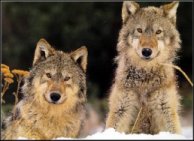
|
One important aspect of wolf development is play. Wolves enjoy playful exchanges with each other. This playfulness starts early, as pups, and continues throughout the wolves' lives. This play helps wolves develop skills for hunting, defending and maintaining pack unity.
|
|
The pack is kept together by strong bonds of affection. Conflict within the pack is unusual and a cause for great distress among the other wolves in the pack. However, wolves are usually hostile towards wolves that do not belong to their own pack, since they are seen as a threat to the pack's unity and survival.
|
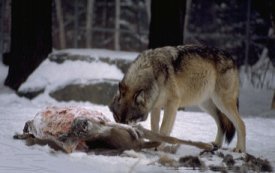
|
Wolves are carnivores, or meat eaters. They are also hunters, and kill their own meat, although they will scavenge in lean times. Their main prey are moose, deer, caribou, elk and sheep. In order for the wolf to catch and kill these animals, which are sometimes as much as ten times larger than itself, hunting is a collaborative effort. The wolves hunt in groups, thereby increasing their strength and their ability to catch their prey.
|
|
A wolf pack will first pick up the scent of the prey. This is done either by following tracks on the ground, or by picking up the airborne scent. After picking up the scent, the wolves move as a highly co-ordinated unit towards their quarry. This must be done quietly, so as not to alert their prey. Once the quarry is found, the wolves will surround the animal, biting it around the backside, sides, neck and head. However, in most cases, the hunt is not successful. Either the intended prey will pick up the scent of the wolves and run, or in the case of the much larger prey such as the moose, the prey will try to fight the wolves off. If the prey is fast, or fights well, the wolves will leave in search of easier game. Wolves often have to go for long periods of time without eating. They can go without food for as long as two weeks. When food is available and plentiful, the wolves will eat enough to make up for the weeks without food. An adult wolf can eat as much as 20 pounds at one killing.
|
|
Another factor in the wolves hunting is the seasons. In the spring and summer, the wolves have an abundance of baby mammals that do not have the ability to run or fight. In the leaner months of the fall and winter, the wolves must rely on the old and sick. These animals are easier to catch. It also aids in the natural order, since the weak and infirm are weeded out of a heard. The hunt is also affected by the wolves' offspring. In the spring and summer months, the wolves' actions are dictated by the litters in the pack. Hunting is usually done at night and the pups are attended to by a pupsitter, usually the Omega of the pack.
|
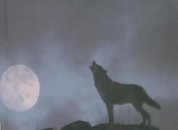
|
One of the most beautiful and haunting sounds found in our world is the howl of a wolf pack. Wolves use many forms of vocalization to communicate; however, their howl is the most distinguishing. Howls are used by a pack to bring a pack together, for celebration, or to protect their territory. Each wolf carries a unique note when howling, which helps to identify where each member of the pack is at any given moment. The howl represents yet another sign of pack unity.
|
|
Wolves rely not only on howls to communicate, but their body language as well as growls, whimpers, whines, barks, and squeals, with each of these carrying different meanings. The whimpering or whining heard from wolves is often a display of friendliness. Wolves use growls to threaten or enforce pack hierarchy, while barks are used to signal alarm. Wolves also use their entire body to communicate, their stances, their facial expressions, their stares, and their tails. Dominance can be shown by a wolf standing on its hind legs, while submissive wolves may roll over on their back and expose their underside to a dominant male.
|
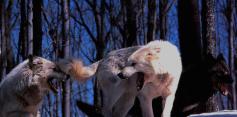
|
One of the most telling forms of body languages that wolves utilize is the tail. The position of the tail can indicate dominance, submission, aggression, fear, and other communications. Such as,
a high, wagging tail can mean that the wolf is in a playful mood, a tucked tail is generally how a wolf will display submissive behavior to a dominant wolf. Additionally, a tucked tail may also indicate fear. A relaxed wolf will often just have it's tail hanging straight down, while a tense or aroused wolf will have a tail pointing straight out. This can indicate that a wolf senses danger or is about to attack.
|
|
Wolves also use their eyes and their scent to communicate. The penetrating stare of a dominant wolf is yet another form of communication used to maintain order within the pack. Scent markings are used to mark a pack's territory and this scent communicates to other wolf packs that the territory is occupied.
|
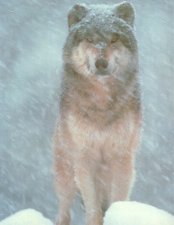
|
The wolf today is an endangered species. This animal, which once roamed freely over most of the North American continent is now only found in isolated patches where reintroduction efforts have been successful. Like many other forms of wildlife, the wolf habitat has dwindled because of human development. When wolves cannot find prey in the wild, they have been known to kill domesticated animals, from cattle to a family's pet. As a result, the wolf has been viewed as the enemy of mankind.While wolves do sometimes prey on livestock, they are responsible for a very small percentage of the livestock deaths in North America. An attack by healthy wild wolves on humans is almost unheard of, and there has never been a fatal attack on a human by a healthy wild wolf in North America. Those attacks that do take place would involve an unhealthy wolf, or a human who is some how inciting the wolf to action or impinging upon the wolf's territory. Other cultures have better views of the wolf. In Roman mythology, the god Mars considered the wolf a sacred animal. Native Americans also hold the wolf in high regard and believe that wolves carry characteristics that humans should also find important, such as strong family structure and teaching the young.
|
|
Public sentiment in the States is now swaying in favor of the wolves. Yet, there are still many problems encountered in building the wolf population back up and removing them, once and for all from the endangered species list. The same people who are now wolf advocates, may feel differently when a wolf makes lunch out of a treasured pet.
|
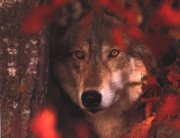
|
Wolves need unsettled land to roam, breed, kill and survive. More and more humans want to live amongst the wildlife. These well-intentioned people are also posing a threat to the wolves' future. A balance must be achieved so wolves can flourish with minimal harm, financial or otherwise, to the humans that share their habitat.
|
|
There seems to be very little in the way of a happy medium about wolves. It will most likely always be a love/hate relationship. However, perhaps humans will better understand wolves by separating out the fact from the fiction. The key to understanding of wolves must come through education. This education must be unbiased, so that people realize that, although wolves are intelligent and beautiful creatures, they are still wild animals. There are several centers open around the country that focus on education. There are also many Websites that focus on realistic education. Some of these are listed in the "True Kindred" section.
|
.:Back:.
|
